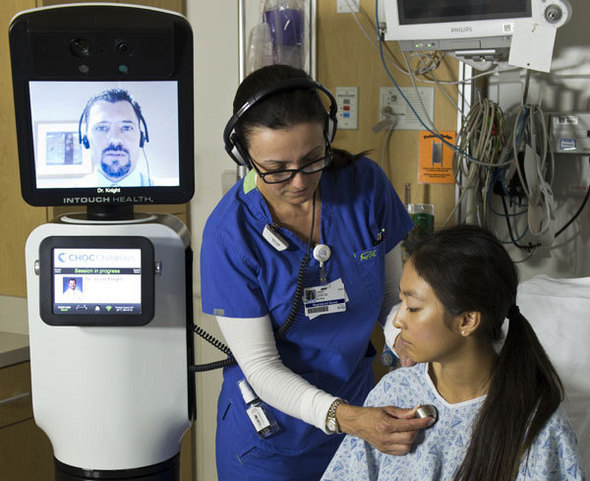
If the Jetsons were any indication of the things to come, we’d all be riding around on our flying cars and have a personal robot to serve as our maid, butler, personal assistant and sometimes nanny. While we might not all have our own personal robot servant, it’s still hard to think about what life would be like without robots. They do everything from clean up industrial waste to manufacture the vehicles and other tools that we use every day. Though they may not be right there in our kitchens helping us do the things we do, they are working silently in the background, creating the products and providing the services that enhance the quality of our lives.
One of the arenas in which robots are being used for cutting edge work is medicine. Robots large and small are being used to treat everything from tumors to thin lips and are being used in innovative ways. Here are 5 amazing ways that robots are being used in medicine right now:
To Train Doctors

10 Medical Robots That Could Change Healthcare
At some point, young med students have to get their noses out of their books and be turned loose on real live patients for “practice.” The training goes on for several more years, with interns, newly licensed doctors and specialists in training learning on the job in their patient care. However, when they are working with real patients, their mistakes are equally real and carry real consequences – maybe even fatal ones.
Robots are being used to help train doctors on a wide range of medical treatments and surgical techniques to help minimize this risk while also giving them the education that they need. Robot patients simulate the real thing with a beating heart, dilating eyes, and the ability to “breathe.” Students can place an IV on the robot, check blood pressure and other vital signs, and even talk with him about his symptoms. Of course, they can also practice a wide range of medical techniques on him.
There are also models for a pregnant woman, a child and a baby.
To Diagnose Disease

‘Living’ Micro-Robot Could Detect Diseases in Humans
Diagnosis of disease is not always as simple as ordering an MRI or looking at the results of a blood test. Sometimes trace elements go undetected in the blood stream or masses are too small to be observed on an X-ray. Other times, some diagnostic procedures are too invasive to be considered worthwhile for early evaluation.
Robots are able to offer more precise diagnostic opportunities that are also less invasive. For example, there is a robot that can use ultrasound to provide 3D diagnostic information about a mass found in the breast. (It can also perform a biopsy if necessary.) Other robots can search for aneurysms or tumors in the brain. Yet another robot can be used to diagnose patients remotely when they are unable to see their primary doctor or to fly out to meet a specialist.
To Perform Surgeries
The daVinci® Surgical Robot
By far, some of the most interesting ways that robots are being used in medicine is to perform surgeries. Robots are able to make more precise movements, greatly reducing the risks involved in surgery. They can also make a greater range of movement through a smaller incision, which can minimize the risk of infection and speed recovery.
Some notable examples of robots being used in surgery include the NeuroArm, which is used for surgery in the brain, and the HeartLander, which can be used to conduct heart surgery without doctors having to crack open a patient’s chest. There are many more robots being used to conduct less invasive surgeries, and we are sure that we’ll see even more developments in this arena in the coming years.
To Rehabilitate Patients

Robot Invasion: Toyota Unveils Four Healthcare “Assistants” [PICS]
After an accident or an injury, patients may have to undergo months or even years or physical therapy and rehabilitation to regain their mobility or full range of function. Robots are being used to help these patients recover more quickly and to provide more effective treatment. For example, one robot is being used to treat patients with muscular atrophy and other neuromuscular diseases to regain strength and function. Robots can be used to provide more challenge to patients in order to promote the fastest gains.
To Restore Lost Limbs and Other Body Parts
‘Terminator’ arm is world’s most advanced prosthetic limb
You’ve heard of the Bionic Man, right? Well, that’s no longer science fiction. Robots are being used to serve the place of lost limbs and other body parts. Bionic contact lenses are even being developed to help replace lost eye sight. Though these new parts won’t cost $6 million (or hopefully not), it must still seem pretty cool for those who get to wear their new robotic arm or leg to walk or regain the full functionality of their limbs.
Scientists are also working on technology to use robots to create a human heart or other organs. They have already used the technology to create an artificial jellyfish, and they are working on moving their research further to include human organs.
Robots and artificial intelligence are only going to become more ubiquitous as the technology advances and more things are made possible. It’s exciting to see how robots are being used in medicine to offer the best treatments and help patients to experience less pain and to recover more quickly. The possibilities seem endless for what we can do.
What other research have you seen sharing some amazing uses for robots or their technology? Share the articles and stories in the comments! Thanks for reading!





This is just brilliant!! Just a great idea for the use of robotics!!